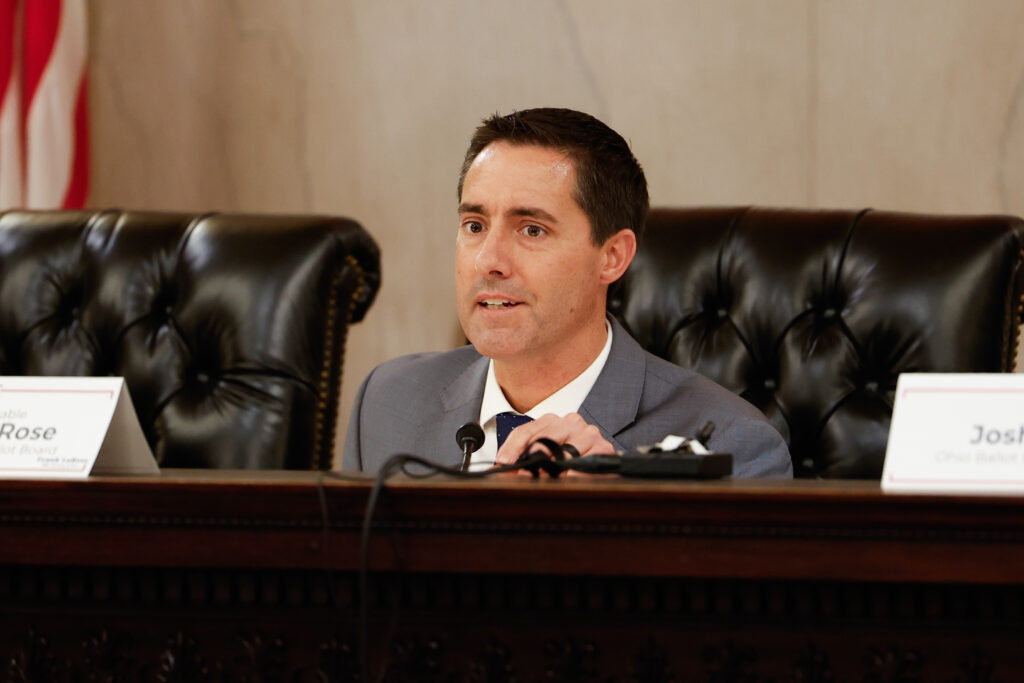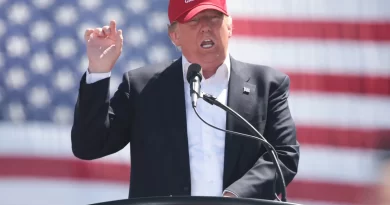Ohio Sec. of State LaRose wants to fight voter fraud, but pulling out of ERIC will make that harder
Last month, a Cuyahoga County judge sentenced James Saunders to three years in prison for voter fraud. The judge’s ruling described how Saunders cast ballots in Ohio and Florida in 2020 and 2022. Although the incidents lie outside the case, he added evidence that suggests Saunders likely voted in both states going back to 2014.
It’s perhaps the most brazen example of voter fraud in Ohio since Secretary of State Frank LaRose took office.
But Saunders’ case doesn’t exactly fit the model of ‘rampant’ voter fraud election deniers portray. Saunders voted twice in multiple elections, but those were individual ballots, not suitcases of them. He’s also a U.S. citizen rather than an undocumented immigrant. And while Saunders isn’t registered with a party in Ohio, he’s given more than $5,600 to Donald Trump and the National Republican Congressional Committee.
I’ll stop at nothing to expose any effort to cheat in Ohio & I’ll call out any attempt to downplay this threat to the integrity of our elections.
— Frank LaRose (@FrankLaRose) February 4, 2022
LaRose didn’t agree to speak for this story, but an Ohio Capital Journal review of his 641 voter fraud referrals found just 18 charges and 13 convictions. Instead of following a pattern, those incidents offer a smattering of isolated, low-level fraud. While Saunders cast his ballots in the two different states in person, there’s just one other example, a person using absentee ballots to vote in multiple states. Ashley Gelman, a Democrat, pleaded guilty to a misdemeanor for voting twice in the 2020 election.
It’s possible there are more cases. Ohio Capital Journal’s investigation found four court-sealed cases and another 12 remain under investigation. It’s not clear whether any of those are related to voters casting ballots in multiple states.
These examples of cross-state voter fraud are extremely rare. But Secretary LaRose has taken a hard line, insisting he’ll “stop at nothing” to root them out. In recent months, however, LaRose has taken steps that will make it harder to catch those incidents in the future.
Cross state referrals
After referrals involving noncitizens, people voting in multiple states make up the largest share of LaRose’s fraud allegations. Since taking office he’s identified 97 of those incidents. He was able to do so thanks to an organization called ERIC.
The Electronic Registration Information Center is a multi-state compact, led by state election officials. Member states pool their data to keep voter rolls up to date and catch potential fraud. It’s a valuable tool, MIT political scientist Charles Stewart argued at a recent panel discussion, because roughly 45% of Americans move between presidential elections.
“We aren’t required to tell anybody that we’ve moved,” he explained, “and most voters believe that when they move, their registration follows them.”
If a voter moves from Ohio to some other member state, they’ll ping ERIC’s database when they register to vote in their new home. Those reports from ERIC can help the Secretary of State identify abandoned registrations here during regular audits.
The ERIC database can also catch that former resident in the rare cases that they apply for an absentee ballot here in Ohio and try to cast another ballot in their new state.
But in March, LaRose decided to pull Ohio out of the compact.

ERIC backlash
In his letter announcing Ohio’s withdrawal, LaRose criticized the inclusion of ex-officio members and requirements that member states take steps to register eligible citizens. LaRose argued members should be able to utilize ERIC’s data to clean up their voter rolls without having to encourage new registrations.
But that dual mission — improving accuracy and encouraging registration — has been ERIC’s charge from the outset. The impetus for ERIC came from a 2012 report from the Pew Center on the States, that found eye-popping deficiencies in U.S. voter rolls. About 24 million Americans’ voter registrations were no longer valid, 2.7 million were registered in multiple states and at least 51 million were eligible but not registered. With help from Pew, seven states established ERIC later that year.
The backlash began in 2022.
In a series of stories, the Gateway Pundit falsely claimed George Soros was funding ERIC and argued its registration efforts were meant to help Democrats. An NPR investigation found while a Soros non-profit contributed to Pew, it was not involved in ERIC. NPR’s story also found the conservative lawyer whose cases provided a kind of blueprint for the Gateway Pundit series didn’t want states to leave the compact at all.
As for voter registration efforts, Chad Ennis from the conservative Honest Elections Project argued that, far from a left-wing plot, they were just costly and ineffective.
“I think the cost at least was a big thing in Texas, and the rigidness,” he said as part of Stewart’s panel discussion. “Because it’s not that we don’t want to reach unregistered people, it’s maybe a mailer is not the best way.”
Ex-officio membership
LaRose’s frustration about ex-officio members is an apparent reference to David Becker. The former DOJ attorney led Pew’s elections program, and while there, helped lay the groundwork for ERIC. He’s a widely respected election policy expert and currently leads the Center for Election Innovation and Research, or CEIR.
He’s also viewed as a kind of boogeyman among some on the right. The Gateway Pundit series called him “truly a scoundrel,” and criticized CEIR for administering voter education grants paid for by Facebook founder Mark Zuckerberg. CEIR’s grants amounted to less than $70 million spread across 22 states and Washington, D.C. They paid for ads, mailers and other communication about voting options, deadlines and policy changes.
Ohio got a grant worth $1.1 million. In CEIR’s report LaRose called the 2020 election “Ohio’s most successful ever.”
“A big part of making that happen depended on educating voters about the many options they had to make sure their voice was heard,” he added, “and the CEIR grant was vital to achieving that mission.”
🧵
Today, I informed @ericstates_info that I will not accept renomination as a non-voting member of the board when my term expires this week. I remain very proud of leading the effort to create ERIC, and supporting its expansion to over half the states in a decade. /1
— David Becker (@beckerdavidj) March 14, 2023
And importantly, LaRose got his way on ex-officio members — but it didn’t matter.
He sent the letter announcing Ohio’s withdrawal the same day ERIC met and voted to remove ex-officio members from its board. Earlier in the week, Becker had also announced he would be stepping down from his position with the organization.
Ohio wasn’t alone, of course. The disinformation campaign against ERIC had already prompted a handful of other states to drop out. At this point a total of nine states, all Republican-led, have left the compact.
The replacements
At a press conference last week for National Voter Registration Day, Becker took a skeptical view of the stopgap initiatives Ohio and other states are rolling out in place of ERIC.
LaRose announced earlier this month that he’d struck separate, one-on-one deals with Virginia, West Virginia and Florida to share voter data. Becker thew cold water on that approach, arguing it seemingly recreates a system called Interstate Voter Registration Crosscheck that preceded ERIC.
Crosscheck had a lot of problems, Becker explained. Data quality was low, which meant extra administrative work a lot of false positives. “A study out of Stanford identified the potential for a false positive rate of 99.5%,” he said, “meaning that every out of every 200 matches it reports only one is accurate.” He added Crosscheck presented numerous security problems as well. Notably, LaRose’s new agreements do require encrypted data transfer.
“They’re scrambling to demonstrate to their voters that they’re still keeping their voter lists up to date,” Becker said of the agreements. “That they’re still combating fraud even though they’ve left what is still the best tool for identifying potential fraud and keeping voter lists up to date.”
Asked directly whether those one-on-one agreements could replace ERIC, Becker said, “the short answer is no, it can’t come close to replacing it.”
He explained ERIC operates as a central hub to collect and process sensitive information. Between the states and Washington D.C. there are at most 51 transmission lines, all going into that hub. With one-on-one agreements, Becker explained, there are two transmission lines for every deal. From Ohio’s perspective, striking deals with every state and D.C. means 102 lines of transmission — doubling the points of vulnerability.
Becker also cast doubt on useful the information could be for addressing voter fraud. He offered “John Smith” as a hypothetical example. Ohio and Virginia report different addresses for him, but the same birthday.
“You know nothing. Those could be two different John Smiths with the same birthday, which happens all the time,” Becker said. “Your ability to clean a list up is going to be hampered by that.”
The approach could lead to an increase in false positives, Becker contends. Since LaRose’s office doesn’t actually handle investigations, that means state and county investigators would likely be combing through a bigger haystack looking for the same number of needles. Already, less than 3% of the secretary’s referrals result in charges.
Becker said ERIC outperforms those one-on-one agreements by combining a broader array of information including from DMVs, the Social Security Administration, and the U.S. Postal Service.
“ERIC can glue all that together to say we are confident this John Smith is the same John Smith,” he said, “and if it’s not, it won’t send it to the states.”
Follow OCJ Reporter Nick Evans on Twitter.
GET THE MORNING HEADLINES DELIVERED TO YOUR INBOX
SUPPORT NEWS YOU TRUST.
This article has been archived for your research. The original version from Ohio Capital Journal can be found here.

